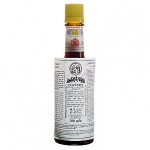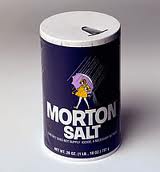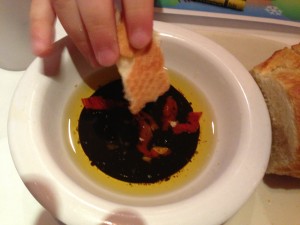Taste buds in your guts? Yes. And cats…they can’t taste sweet.

Learning to appreciate food is genetic. JJ and is Grandmother- my mom, the best cook I know
Taste may have evolved to facilitate finding foods that have nutritional value and to avoid foods that are harmful. Taste and the ability to differentiate taste is genetic. Coded in our very DNA, and different between individuals. But the ability to detect subtle changes in flavors can be learned by the majority of people. Taste buds are not just found in the tongue, but throughout the entire GI tract, the lung, and the spinal cord! Taste buds throughout our body don’t all function to provide a sense of taste but are used to trigger other reactions.
Myth: The tongue has certain regions that detect specific tastes: Years ago there was the theory that different regions of the tongue detected specific tastes- but that tongue map was incorrect. One can taste the bitter, sour, sweet, savory, and salty throughout the tongue.
BITTER
Bitter is the most sensitive of the tastes. The classic biter taste is quinine (think tonic water).
Bitter tastes are thought to have evolved to help us avoid toxins. Eat some bad shellfish, and while their bitter taste may not “taste” bad to your tongue, the taste buds in the stomach will sense them. The taste buds in your stomach don’t send a signal to your brain about “taste” but instead are used for other functions. The stomach taste bud sends a signal that stop the muscles of the stomach from pushing the bad food past your stomach and then trigger a center in your brain for nausea. Once you regurgitate the bad food, and the stomach no longer senses that bitter taste, the signal to the brain stops, and you no longer have nausea. Somewhere in your brain, as you recover from the bad shellfish, a memory is linked and it is unlikely you will eat shellfish in that form again (be it a bad clam, or restaurant, or city).
Not all that tastes bitter is noxious or harmful. On a hot day a refreshing gin and tonic is delicious. The bitterness of the tonic evoking some good memories. But gin and tonic is more than just another drink. Gin and tonic replaced the classic afternoon tea in the tropical colonies of the British Empire, especially in the colonies where there was malaria. Quinine (tonic) was a potent anti-malarial drug for years, until the parasites became resistant to it. So the afternoon tonic really was medicine. Todays tonic water has much less quinine than used in the past.

Coffee has a bitter flavor that some supertasters find noxious. Clearly my son seen here- adding cream and sugar to coffee- he is a supertaster
Coffee, tea, wine , pickles, stout beer, juju beans, rhubarb, unsweetened chocolate- all contain elements of bitter, and all of those elements allow us to enjoy some great foods. For those who enjoy a great Manhattan, the adding of “bitters”- makes the drink perfect. Bitters are herbs infused with alcohol – such as sarsaparilla cassia, wild cherry bark, and others which used to be sold as medicine, but were discovered to add depth to drinks. Modern artesian bartenders make their own bitters, but most bars (home and others) buy bitters.
SUPERTASTERS
Bitter tastes also distinguishes people who are called supertasters. They can taste some highly bitter ingredients that most people cannot detect (this is genetic). Supertasters have amazing palates, being able to distinguish subtle ingredients in foods. Sadly, being a supertaster does not mean enjoying more foods. Supertasters find some bitter ingredients unpalatable, be it coffee, wine, chocolate, green leafy vegetables, and peppers.
If you find that you cannot tolerate the trend in stronger coffee, and prefer your coffee with a lot of cream and sugar you might be a supertaster.
SUPERTASTERS , PEPPERS, AND HEALTH
Supertasters have more taste buds, and this is a blessing and a curse. Every taste bud in the tongue has nerves that have pain fibers. Supertasters not only have more taste buds in their tongues, they have more pain fibers associated with them. As a result, supertasters are less likely to enjoy “peppers” because they are simply more painful to them.
The ingredient that causes spicy heat is a molecule called capsaicin. Many researchers have examined the role of capsaicin in weight management. The consensus is that there is a small, but consistent role for these peppers in decreasing intake of food, as well as burning body fat. Supertasters have a difficult time tolerating enough peppers to obtain this effect.
The Scoville Unit
Did you know hot things can be categorized? In fact, the measurement for foods that are hot is known as the Scoville unit. This heat-measuring unit relates specifically to the heat receptors in the skin and mucous membranes of chile peppers. Pharmacist Wilbur Scoville decided to dilute peppers in sugar water until there was no sense of the pungency or piquancy of the peppers. Red sweet peppers rate a 0, while the world’s hottest pepper—the Naga Jolokia (the ghost pepper)—has a rating of 1,040,000 Scoville units. What are those hottest peppers used for? They are placed on fences and posts to keep elephants away. Jalapeño peppers are 2,500 to 8,000 units. Cayenne and Tabasco peppers are 30,000 to 50,000 units. Habanero peppers are 100,000 to 350,000 units. Instead of getting five people together to agree on this, the measurement of piquancy is now done through liquid chromatography. But Scoville units are used a lot by people who love chiles, and by those who sell various chile powders. Adding a bit of heat to something is useful for culinary purposes because it is the inflammation on the mucous membrane of the tongue that will make flavors far more intense. Sweetness is sweeter, as is bitterness, and salt. All those become more intense with inflammation.
People who have more spices in their diet appear to have less Alzheimer’s or other neurodegenerative disease. There is some evidence that spices including red pepper, black pepper, and turmec, among others, may decrease inflammatory diseases especially those that effect the brain. Like any population study, the idea that there is less neurodegenerative disease among some people may be an error in the data, but when examined, those spices do have an effect on the pathways leading to inflammation. (78).
On the other hand supertasters have a more pleasant sensation from fat. Supertasters tend to avoid smoking, as well as alcohol as it just doesn’t taste pleasant to them. Supertasters tend to dislike broccoli, brussel sprouts, kale and other green vegetables that contain flavanoids, which are thought to have a beneficial effect in preventing cancers. Supertasters tend to be “meat and potato” eaters – preferring their simple flavors. Supertasters taste help them to avoid lifestyle choices associated with heart disease (less likely to smoke) and liver disease (less likely to drink) but they tend to have a less balanced diet. Supertasters can still enjoy green, leafy vegetables by altering the method of cooking, or by eating some vegetables raw. Brussels sprouts, for example, are found disliked by supertasters, because people overcook them leaving Brussels sprouts bitter, but when cooked gently Brussel Sprouts are quite palatable to supertasters.
YOUR OWN SUPERTASTER TEST
About 70% of the population can taste a highly bitter compound called phenylthiocarbamide (PTC). To those individuals, this compound is highly bitter, for the other 30% of people they cannot taste a thing. The ability to taste this is genetic, and associated closely with supertasters. Most people are unlikely to find PTC in any recipe, but it is a clear marker for a subset of supertasters. You can purchase this compound but you can do your own test. For this you will need blue food coloring, a reinforcer for a hole-punch (a circle about 6 mm wide), and a magnifying glass. Rub the blue food coloring on your tongue – the taste buds will remain red. Then count the bumps in the 6 mm circle: normal tasters have about 15-35 taste buds per 6 mm, while supertasters have 35 or more.
One caveat – tongues change with time. Trauma can alter the number of taste buds in a given area – don’t be surprised if there are small areas of your tongue that have no taste buds. A variety of injuries can alter the anatomy of taste buds, including smoking (which can, contrary to popular belief, enhance certain tastes – but inhibit the ability to smell).
The best supertaster test is one of your own tastes: if you find you don’t care for sweets, spicy-hot foods, green leafy vegetables, strong coffee (without putting cream or sweetener in it), and have a hard time with some wines- you probably are a supertaster. But fear not, you can learn to appreciate and enjoy these flavors – it just takes some time and patience.
CILANTRO
Some people love cilantro combined with seafood in a civiche, salsa, or Italian food. But there is a group of individuals who find Cilantro soapy and unpleasant. Fabio Viviani, chef and restauranteur of Top Chef and Life After Top Chef, fame – says “Cilantro freaks me out,” and allows no cilantro in his restaurants. Julia Child didn’t like cilantro at all, and banned it from her recipes. The love, or lack of love, for cilantro is also genetic – but it is not taste, it is smell. The difference between taste and smell is key. If you don’t like cilantro, try tasting it by plugging your nose – most will taste something akin to parsley. Cilantro has a lot of chemicals the evoke a smell, these are called aldehydes. For those who hate cilantro, they smell some aldehydes but those who love cilantro smell other aldehydes- which are picked up from a different spectrum.
SWEET
Sweet is the taste of sugar. Supertasters are not great lovers of sweets, but those who are not supertasters easily become accustomed to more sweetness. To balance the sweet, people end up eating more savory or salty foods. Colas have a lot of salt, and a lot of sweet. The sweet masks the salt, and the salt is designed to get you to want to drink more.
Cats don’t have the taste for sweets – it is thought that one of the reasons that cats developed a taste for meat, which was not good for the local population of mice or birds. Many cat foods contain carbohydrates, some as much as 20% which the cats can not taste, but their systems are not designed for those sweets. This sometimes drives the house cat to seek more savory items, like birds. Cats are such efficient predators, that they have been classified as an invasive species, and have threatened wildlife in Florida, Hawaii, and other places. Some of this is simply their taste driving them to eat, and part because the cat food commonly sold will not satisfy them, and may even harm them (one reason some domestic cats develop diabetes).
The taste buds present in the stomach and the first part of the intestine (duodenum), don’t provide a “taste” sensation to the brain, but help prepare the body for the glucose that is coming. Glucose is the most important fuel of the body- every cell uses it, every cell is dependent upon it. Because of that, there is an evolutionary advantage to absorbing glucose as rapidly as possible. The intestinal taste buds facilitate the transport of glucose from the intestine into the blood stream. There are cells that actively transport glucose into the bloodstream. When the intestinal taste bud senses the sweetness, it also signals those cells to turn on so they are prepared to actively transport glucose. People who have undergone gastric bypass surgery for obesity, or a Roux En Y gastric bypass for ulcer disease, have bypassed these taste buds in the duodenum, and when tested these individuals have less ability to respond to glucose challenges. This is thought to be one of the mechanisms for weight loss from the gastric bypass operation.
While today the availability of glucose isn’t an issue, it was for primitive man. Sources of sweetness for them might include berries, grains, and honey. Having the ability to transport glucose from starches from fruits and vegetables, was an evolutionary advantage.
In addition to facilitating the transport of glucose into the blood stream these gut taste buds stimulate hormones called incretins that turn on pancreatic insulin production. If you inject glucose directly into the blood (like we physicians do when we give intravenous fluids) you get much less insulin production than if you eat the sweets. That is because when you eat sweets, those sweet taste buds in the intestine set off the mechanism to prepare for the glucose.Insulin is a hormone (protein) that increases the ability to store glucose (sugar) in the liver and muscles. Insulin lowers blood glucose by increasing the conversion of the glucose to glycogen. The vast majority of glucose is stored as glycogen, not fat. Again an advantage, because if too much glucose is in the bloodstream the body will excrete it through kidneys. The ability to store excess glucose as glycogen provides ready material for energy production needed for muscles, including the heart, as well as the brain.
You probably wondered if there is any way that rats differ from humans: if you feed a rat pure glucose when the rat first tastes the glucose their bodies produce insulin but not humans don’t. However, if you feed a human apple pie- they produce insulin – for humans, the taste of food stimulates more than just the “sweetness” which shows that humans have more sophisticated response to food than rats.
The glycemic index, a measurement of glucose response to various foods, is determined not by the amount of glucose in the food (bread has a higher response than pure glucose) but by the sweetness that the stomach and intestines sense in the taste buds.
Fructose, while sweet (the other half of the table sugar molecule) does not turn on the insulin response, although since it is often paired with glucose, as in table sugar or high fructose corn syrup. But fructose does blunt the response of insulin, and since insulin is one of the signals that tells you that you have eaten enough , fructose can drive people to eat more food. While Paleo diet people think bread is the problem with diets, because of its increased glycemic response, it is really the fructose, in its refined form (table sugar, high fructose corn syrup) that is more of the issue.
SALT
Salty flavor is classic table salt, or sodium chloride.
Placing salt on meats before they are cooked is called seasoning. This does not lead to a salty flavor. Seasoning salt makes the surface of the meat prime for chemical reactions of heat, providing great smells and textures (this is known as the Maillard reaction). Adding salt after the cooking process is what leads to the salty flavor and can be overdone—salty food isn’t good; seasoned food is.

In most cooking stores you can purchase four basic salts: common table salt, kosher salt, sea salt, and fleur de sel. Some salts vary in color because they are gathered from tidal pools with algae. The main ingredient in all of these salts is the chemical sodium chloride. Salts range in price from pennies per ounce to dollars per ounce. While the crystal shapes of these salts are different, in blind taste tests most people can tell no difference between them. Many cooks use kosher salt to season meats and poultry; a touch of sea salt on cooked vegetables; and the fine fleur de sel as a finishing salt on some dishes. Kosher salt is used for seasoning because of its size, shape, and it is inexpensive. If you do not season meats with salt, then the taste of the meat becomes quite bland.
Seasoning, or salting the meat before cooking, dries the surface of the meat. When that surface is then placed against a high heat there is a nice crust that is formed, and many of the delicious smells of the meats come out. Try this: make two small hamburgers on a grill – with one season with salt and pepper before grilling. With the other, just place it on the grill. Taste both- you will like the seasoned meat much better. Same with chicken, lamb, and all meats.
Because some people must limit salt for health reasons, a number of salt substitutes have been developed. Lithium salts and potassium salts taste like table salt and have been used as salt substitutes. Lithium was found to have an effect on the brain and now lithium is a mainstay in the treatment of bipolar disorder.
Lithium is found in various foods, especially grains and vegetables and in some water supplies. When a water supply has lower lithium the community it supplies has increased rates of suicide, homicides, and arrests for drug use. It is considered now an “essential” micronutrient with the Recommended Daily Allowance of 1,000 mcg per day. There have been many experimental anecdotes with lithium – one of the most famous was that Romans noted that some spring water helped in the treatment of “mania.”
Too much salt is not healthy. But you need salt to live, and you need salt for flavor. Poor-quality restaurants (most chains) and most convenience foods contain more salt than is found in recipes in common recipe books.
HOLIDAY HEART AND SALT
Salt and heart failure are well linked, mostly because as you eat more salt, and you retain more water. Ever notice how you feel a bit bloated after vacation, are a bit swollen. With a good heart and good kidney’s that excess salt you took will gently be expelled. But if your heart doesn’t work that well, the extra salt will increase the volume of fluid in your blood. That makes it harder for your heart to work well- which can lead to either heart failure (fluid on the lungs) or to where the heart is stretched so much the electrical system will short- and when your heart shorts it typically stops. There is a well defined season between Christmas and New Years where deaths from heart issues are higher than any other time of the year.
SOUR
Sour is the taste found in vinegar, lemons, limes, and pickles. Sour taste evolved to protect us against many spoiled foods. Although learning to preserve foods often involves a sour taste. Kim Chi has a potent sour taste, but the ability to preserve cabbage allowed people on the Korean peninsula to survive harsh winters. Learning to love that sour taste is a part of adaptation of the sensory system.
Sour detects “acidic” foods, but those taste buds are also found in the spine where they help regulate the pH of spinal fluid. That sounds obscure, but if bacteria enter the spinal fluid they begin to feed off the glucose, and the byproduct of the bacteria is acidic. Early detection of acid provides a warning system of infection, signals white blood cells to come in and eat the bacteria, and promote a change in the pH of the spinal fluid to something that is less hospitable to the bacteria.
Sour candy, sweet tarts, skittles, all contain citric acid that produce a burst of sour flavor on the tongue. Some elements of bitter are found with sour – and that is because when most items become bitter (as they age) get more acidic. Vinegar is sour because it started out as grape juice, but as the bacteria or yeast used the glucose as fuel, they converted it to a mild acid. The detection of sour can be a good thing, as it is in cheese, candy, pickles, or a bad thing- as when milk has gone sour. Sour provides an early detection of “bad bacteria” or an early detection that the balsamic vinegar is perfect.
The ability to detect the differences was key to survival to early man.
SAVORY or UNAMI

There is no Italian Restaurant Syndrome, and yet more MSG is found in Italian food than Chinese food
Savory is the flavor of meats and soy sauce. A good steak or great mushrooms have a deep savory flavor. MSG is the classic savory flavor. Much maligned, it is MSG that gives the savory flavor to Doritos, parmesan cheese, and tomatoes. There is more MSG in Italian food than Chinese food, but you don’t hear about an “Italian Food Syndrome.” While Chinese Restaurant Syndrome is not caused by MSG, most people still associate the two as it is still in the popular press. I discuss MSG in a previous article.
BALANCE
With taste one needs balance. Anything that has too much of one taste will overwhelm and make the dish uninteresting. When you watch judging of dishes made by chefs on TV shows, like Chopped, Top Chef, or Iron Chef – you will hear the judges refer to a “balance” in the dish. This means that the elements of the dish do not overwhelm with one of the tastes. If you have a sweet element, it is balanced with a bit of salt, or if you have a sour element there is a savory element.
Coca-cola has elements of sweet, salt, and sour – providing a balance of flavors, that makes it go well with a hamburger (savory).
You will also fill up fast when you only use one taste sensation. This is the basis for many diets: You tire of that taste and thus you eat less. Anyone who tries the Atkins diet is likely to tire of savory dishes (people who didn’t think they would ever get tired of eating steak, do). The ice cream diet, the salami diet, the cookie diet, all of those diets which sound good to start with, end up overwhelming the palate with a single flavor (one note ) and you eat less as time goes on.
When cooking dishes, having a balance on the plate provides a great meal. Think of bread and dipping it in a combination of olive oil, balsamic vinegar, with some sardines. The sardines provide salt, the balsamic both sour and bitter, and olive oil the savory – with the bread providing the sweet. A perfect balance.

Olive oil, balsamic vinegar, sardines all provide elements of taste – the sour, salty, and savory, combine with bread- the sweet and you have a perfect balance
LEARNING NEW FOODS
Probably the first time you tried some foods you didn’t like them, but in time you came to appreciate them. When you first drink French wine it may taste like old socks, but as you grow to appreciate it you learn to taste the subtle differences in the soil where the wine was grown. Chardonay from the Montrachet district is a white wine with more complexities than most red wines – but if you are use to drinking most US white wines, this will provide a bold new set of flavors.
If you are a supertaster, learning what you can do to eat healthier, learn new food combinations, becomes a joy, and not a burden. It is a flavor palate, and it requires something simple — taste the food. The more you find the subtle differences in great food that you enjoy, the less you will enjoy plain food. Have meat that is properly seasoned and you will know when a restaurant seasons properly (a failing of many foods).
Today we live in a society of cheap, but very bland foods. But there are true artisans of food, that take their craft seriously. The taste difference between their foods- such as the blue-foot chicken versus the grocery store chicken, is large. It means if you want great food you will pay more, but the benefits to your taste are clear:
(a) chances are you will learn to cook, to obtain the best ingredients for yourself and family
(b) you will eat less, because you will savor more

There is nothing like freshly caught fish
(c) as you add more spices, introducing more flavors, you learn what is too much, and what is not enough
Or, in my journey from Alaska to the lower 48, when you have freshly caught salmon you will not be satisfied with frozen, farm-raised salmon again.
REFERENCES:
T2R38 taste receptor polymorphisms underlie susceptibility to upper respiratory infection Lee RJ, Xiong G, Kofonow JM, Chen B, Lysenko A, Jiang P, Abraham V, Doghramji L, Adappa ND, Palmer JN, Kennedy DW, Beauchamp GK, Doulias PT, Ischiropoulos H, Kreindler JL, Reed DR, Cohen NA. J Clin Invest. 2012 Nov 1;122(11):4145-59.
Transformation of postingestive glucose responses after deletion of sweet taste receptor subunits or gastric bypass surgery. Geraedts MC, Takahashi T, Vigues S, Markwardt ML, Nkobena A, Cockerham RE, Hajnal A, Dotson CD, Rizzo MA, Munger SD. Am J Physiol Endocrinol Metab. 2012 Aug 15;303(4):E464-74. PMID: 22669246
Neuroprotection by spice-derived nutraceuticals: you are what you eat! Kannappan R, Gupta SC, Kim JH, Reuter S, Aggarwal BB. Mol Neurobiol. 2011 Oct;44(2):142-59. Pub Med ID 21360003
The effects of capsaicin and capsiate on energy balance: critical review and meta-analyses of studies in humans. Ludy MJ, Moore GE, Mattes RD. Chem Senses. 2012 Feb;37(2):103-21 PMID: 22038945
Taste isn’t just for taste buds anymore. Finger TE, Kinnamon SC.F1000 Biol Rep. 2011;3:20. PMID: 23041624
Lithium: occurrence, dietary intakes, nutritional essentiality. Schrauzer GN. J. Am Coll Nutr 2002 Pub Med ID 11838882
Diastolic heart failure: a confusing concept. Dorhout Mees EJ. Heart Fail Rev 2012 Pub Med ID 22961410
